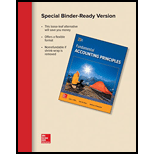
Loose Leaf for Fundamental Accounting Principles
23rd Edition
ISBN: 9781259687709
Author: John J Wild, Ken Shaw Accounting Professor, Barbara Chiappetta Fundamental Accounting Principles
Publisher: McGraw-Hill Education
expand_more
expand_more
format_list_bulleted
Question
Chapter 21, Problem 13DQ
To determine
Cost behavior analysis means study that how the cost changes with the change in activity level or production volume. Cost behavior is not compulsory under any GAAP but it is an important part of the organization efforts to control the costs and maximization of profits. It is also necessary to calculate the break-even point and cost-volume profit analysis.
Cost behavior can be analyzed using various methods:
- High-low method/ equation method
- Scatter diagram method
- Regression analysis
To determine:
In the given question we have to explain that how the scatter diagram is used to identify and measure the behavior of a company’s cost.
Expert Solution & Answer
Trending nowThis is a popular solution!

Students have asked these similar questions
When do organizational boundaries require special accounting treatment? (a) Standard rules work everywhere (b) Physical locations define all boundaries (c) Virtual operations blur traditional entity definitions d) Boundaries never change
I need help with this general accounting question using standard accounting techniques.
Please give me answer with accounting
Chapter 21 Solutions
Loose Leaf for Fundamental Accounting Principles
Ch. 21 - Prob. 1DQCh. 21 - Prob. 2DQCh. 21 - When output volume increases, do fixed costs per...Ch. 21 - Prob. 4DQCh. 21 - Prob. 5DQCh. 21 - Describe the contribution margin ratio in...Ch. 21 - Prob. 7DQCh. 21 - Prob. 8DQCh. 21 - Prob. 9DQCh. 21 - Prob. 10DQ
Ch. 21 - How does assuming that operating activity occurs...Ch. 21 - Prob. 12DQCh. 21 - Prob. 13DQCh. 21 - Prob. 14DQCh. 21 - Prob. 15DQCh. 21 - Prob. 16DQCh. 21 - Prob. 17DQCh. 21 - Prob. 18DQCh. 21 - Prob. 19DQCh. 21 - Prob. 20DQCh. 21 - Prob. 21DQCh. 21 - Prob. 22DQCh. 21 - Prob. 1QSCh. 21 - Prob. 2QSCh. 21 - Prob. 3QSCh. 21 - Prob. 4QSCh. 21 - Prob. 5QSCh. 21 - Prob. 6QSCh. 21 - Prob. 7QSCh. 21 - Prob. 8QSCh. 21 - Prob. 9QSCh. 21 - Prob. 10QSCh. 21 - Prob. 11QSCh. 21 - Prob. 12QSCh. 21 - Prob. 13QSCh. 21 - Prob. 14QSCh. 21 - Prob. 15QSCh. 21 - Prob. 16QSCh. 21 - Prob. 17QSCh. 21 - Prob. 18QSCh. 21 - Prob. 19QSCh. 21 - Prob. 20QSCh. 21 - Prob. 21QSCh. 21 - Prob. 1ECh. 21 - Prob. 2ECh. 21 - Prob. 3ECh. 21 - Exercise 21-4 Measurement of cost behavior using a...Ch. 21 - Prob. 5ECh. 21 - Prob. 6ECh. 21 - Prob. 7ECh. 21 - Prob. 8ECh. 21 - Prob. 9ECh. 21 - Prob. 10ECh. 21 - Prob. 11ECh. 21 - Prob. 12ECh. 21 - Prob. 13ECh. 21 - Prob. 14ECh. 21 - Prob. 15ECh. 21 - Prob. 16ECh. 21 - Prob. 17ECh. 21 - Prob. 18ECh. 21 - Prob. 19ECh. 21 - Prob. 20ECh. 21 - Prob. 21ECh. 21 - Prob. 22ECh. 21 - Prob. 23ECh. 21 - Prob. 24ECh. 21 - Prob. 25ECh. 21 - Prob. 26ECh. 21 - Prob. 27ECh. 21 - Prob. 1APSACh. 21 - Prob. 2APSACh. 21 - Prob. 3APSACh. 21 - Prob. 4APSACh. 21 - Prob. 5APSACh. 21 - Prob. 6APSACh. 21 - Prob. 7APSACh. 21 - Prob. 1BPSBCh. 21 - Prob. 2BPSBCh. 21 - Prob. 3BPSBCh. 21 - Prob. 4BPSBCh. 21 - Prob. 5BPSBCh. 21 - Prob. 6BPSBCh. 21 - Prob. 7BPSBCh. 21 - Prob. 21SPCh. 21 - Prob. 1BTNCh. 21 - Prob. 2BTNCh. 21 - Prob. 3BTNCh. 21 - Prob. 4BTNCh. 21 - Prob. 5BTNCh. 21 - Prob. 6BTNCh. 21 - Prob. 7BTNCh. 21 - Prob. 8BTNCh. 21 - Prob. 9BTN
Knowledge Booster
Learn more about
Need a deep-dive on the concept behind this application? Look no further. Learn more about this topic, accounting and related others by exploring similar questions and additional content below.Similar questions
- I am looking for help with this general accounting question using proper accounting standards.arrow_forwardI need help finding the accurate solution to this general accounting problem with valid methods.arrow_forwardPlease explain the correct approach for solving this general accounting question.arrow_forward
- expert of accounting questionarrow_forwardCan you solve this financial accounting problem with appropriate steps and explanations?arrow_forwardHow do profit-sharing obligations affect interim financial reports? a) Record estimated annual amount b) Use prior year percentages c) Pro-rate based on quarterly profits d) Wait until year-end calculationarrow_forward
- Crosby Manufacturing had total manufacturing costs of $485,000 during FY 2023. Their cost of goods manufactured for the year was $512,000. The January 1, 2024 balance of the Work-in-Process Inventory is $57,000. Use this information to determine the dollar amount of the FY 2023 beginning Work-in-Process Inventory.arrow_forwardGeneral accountingarrow_forwardWhat is the correct amount of their itemized deductions?arrow_forward
arrow_back_ios
SEE MORE QUESTIONS
arrow_forward_ios
Recommended textbooks for you

 AccountingAccountingISBN:9781337272094Author:WARREN, Carl S., Reeve, James M., Duchac, Jonathan E.Publisher:Cengage Learning,
AccountingAccountingISBN:9781337272094Author:WARREN, Carl S., Reeve, James M., Duchac, Jonathan E.Publisher:Cengage Learning, Accounting Information SystemsAccountingISBN:9781337619202Author:Hall, James A.Publisher:Cengage Learning,
Accounting Information SystemsAccountingISBN:9781337619202Author:Hall, James A.Publisher:Cengage Learning, Horngren's Cost Accounting: A Managerial Emphasis...AccountingISBN:9780134475585Author:Srikant M. Datar, Madhav V. RajanPublisher:PEARSON
Horngren's Cost Accounting: A Managerial Emphasis...AccountingISBN:9780134475585Author:Srikant M. Datar, Madhav V. RajanPublisher:PEARSON Intermediate AccountingAccountingISBN:9781259722660Author:J. David Spiceland, Mark W. Nelson, Wayne M ThomasPublisher:McGraw-Hill Education
Intermediate AccountingAccountingISBN:9781259722660Author:J. David Spiceland, Mark W. Nelson, Wayne M ThomasPublisher:McGraw-Hill Education Financial and Managerial AccountingAccountingISBN:9781259726705Author:John J Wild, Ken W. Shaw, Barbara Chiappetta Fundamental Accounting PrinciplesPublisher:McGraw-Hill Education
Financial and Managerial AccountingAccountingISBN:9781259726705Author:John J Wild, Ken W. Shaw, Barbara Chiappetta Fundamental Accounting PrinciplesPublisher:McGraw-Hill Education


Accounting
Accounting
ISBN:9781337272094
Author:WARREN, Carl S., Reeve, James M., Duchac, Jonathan E.
Publisher:Cengage Learning,

Accounting Information Systems
Accounting
ISBN:9781337619202
Author:Hall, James A.
Publisher:Cengage Learning,

Horngren's Cost Accounting: A Managerial Emphasis...
Accounting
ISBN:9780134475585
Author:Srikant M. Datar, Madhav V. Rajan
Publisher:PEARSON

Intermediate Accounting
Accounting
ISBN:9781259722660
Author:J. David Spiceland, Mark W. Nelson, Wayne M Thomas
Publisher:McGraw-Hill Education

Financial and Managerial Accounting
Accounting
ISBN:9781259726705
Author:John J Wild, Ken W. Shaw, Barbara Chiappetta Fundamental Accounting Principles
Publisher:McGraw-Hill Education
How To Analyze an Income Statement; Author: Daniel Pronk;https://www.youtube.com/watch?v=uVHGgSXtQmE;License: Standard Youtube License